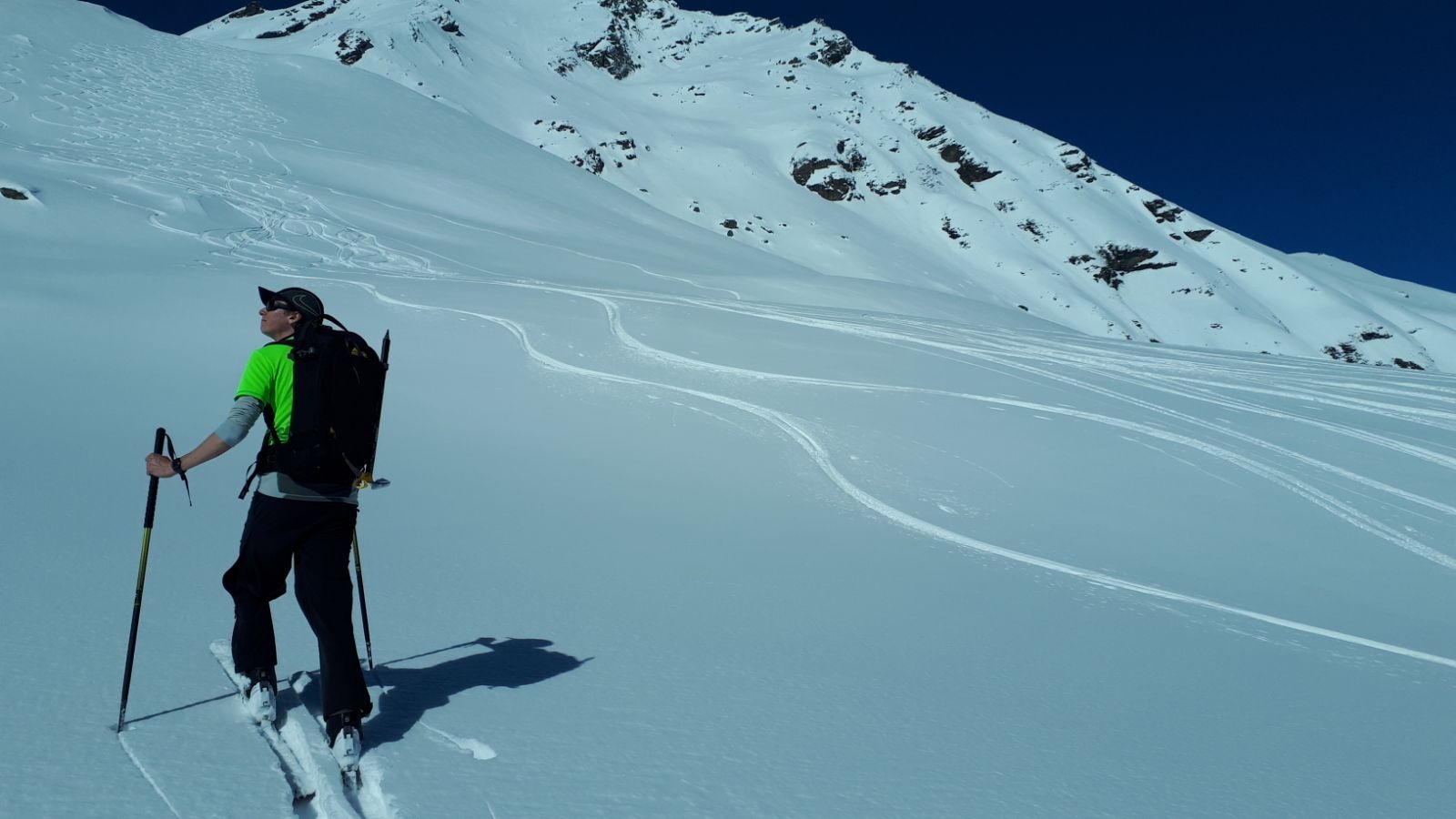We use cookies to ensure you get the best experience on our website. More Info.
How to choose your touring skis, bindings and boots
Choosing your touring ski
Touring skis typically have a lighter core and lack the metal or other laminate materials found in alpine skis, thereby saving on weight. The shapes and technologies used in touring skis are evolving with every season, and the choice of equipment may indeed be difficult, particularly to those who are new to the discipline. Below are a number of general criteria to consider when choosing your touring skis.
Ski width (underfoot):
-
 85-90mm (or less): Designed for rapid and efficient uphill travel, even on steeper terrain. Their low weight ensures that they are less tiring to ski uphill with and also to carry on your backpack. Light and narrow skis not only have less drag on the uphill (as the skins are obviously also narrower) but are also highly maneuverable when skiing in steep, tight couloirs. They may however need to be skied with a more traditional tecnique (shorter, linked turns) and while they will have better edge grip on icy terrain, they will require more effort to stay afloat in fresh, deep snow. Coupled with a lightweight binding, these skis are a great choice for those looking to do long, technical tours in all types of conditions, or for fitness-oriented skiers who priviledge uphill comfort and efficiency. Examples include the Blizzard Zero G 85, Atomic Backland 85, Rossignol Seek 7, Kästle TX82 et TX90, Dynastar Vertical Eagle as the Black Crows Orb Freebird.
85-90mm (or less): Designed for rapid and efficient uphill travel, even on steeper terrain. Their low weight ensures that they are less tiring to ski uphill with and also to carry on your backpack. Light and narrow skis not only have less drag on the uphill (as the skins are obviously also narrower) but are also highly maneuverable when skiing in steep, tight couloirs. They may however need to be skied with a more traditional tecnique (shorter, linked turns) and while they will have better edge grip on icy terrain, they will require more effort to stay afloat in fresh, deep snow. Coupled with a lightweight binding, these skis are a great choice for those looking to do long, technical tours in all types of conditions, or for fitness-oriented skiers who priviledge uphill comfort and efficiency. Examples include the Blizzard Zero G 85, Atomic Backland 85, Rossignol Seek 7, Kästle TX82 et TX90, Dynastar Vertical Eagle as the Black Crows Orb Freebird. -
 90-100mm: A good compromise between uphill efficiency and float in softer snow. Compared to the previous category these skis may be a little more cumbersome when going up on a steep, off-cambered, icy skin-track but their additional weight, surface area, and resistance to deflection mean that they can generally be skied faster, more agressively and with a wider range of turn radii. Their versatility in all types of snow also makes these skis better suited for intermediate and heavier skiers looking for a more stable, confidence-inspiring and forgiving ride. Skis of this width are a great do-it-all option for those who want to enjoy the downhill as much as the uphill. Examples include the Blizzard Zero G 95, Black Crows Camox Freebird, Kästle TX98, Atomic Backland 95, Dynafit Beast 98 ou le Dynastar Mythic 97, FX HP 96.
90-100mm: A good compromise between uphill efficiency and float in softer snow. Compared to the previous category these skis may be a little more cumbersome when going up on a steep, off-cambered, icy skin-track but their additional weight, surface area, and resistance to deflection mean that they can generally be skied faster, more agressively and with a wider range of turn radii. Their versatility in all types of snow also makes these skis better suited for intermediate and heavier skiers looking for a more stable, confidence-inspiring and forgiving ride. Skis of this width are a great do-it-all option for those who want to enjoy the downhill as much as the uphill. Examples include the Blizzard Zero G 95, Black Crows Camox Freebird, Kästle TX98, Atomic Backland 95, Dynafit Beast 98 ou le Dynastar Mythic 97, FX HP 96. -

-
100mm or more: These are touring skis with a clear focus on downhill and soft snow performance. If you are looking to tour mainly in fresh snow (avalanche risks permitting of course) or if you are looking to do short hikes out of resort boundaries to reach fresh lines, then this is the ideal category for you. Keep in mind that the weight (and often shape) of wider skis makes them more cumbersome on long outings with a lot of positive altitude, as well as when you encounter steep, icy terrain. Such skis may also require slightly burlier touring boots and bindings to ensure for the best energy transfer and responsiveness from the ski. Examples include the Black Crows Navis, Corvus et Anima, ainsi que le Ferox Freebird, ou le Dynastar Cham 107.
-
Rocker and sidecut:
As with freeride skis, touring skis that have tip rocker (or "early rise") can be beneficial when breaking trail or skiing in fresh and difficult snow. However, a significant amount of tip rocker will reduce the length of the contact area between ski and snow, leading to a less secure feel and more side-slipping when walking up and skiing down steep, icy terrain. If you are looking to tour in all types of conditions and on technical terrain, a ski with less tip rocker (for example the Blizzard Zero G) will be more confidence-inspiring both on the uphill and the downhill. However if you are touring predominantly on days when there is fresh snow – or perhaps in areas with less steep gradients – a ski with more pronounced tip rocker (for example the Rossignol Seek 7 or the series Kästle TX) will ensure for a more playful freeride-feel on the down.
For the reasons above, tail rocker is also typically reduced (if not completely eliminated) in touring skis. Rockered tails are also more prone to slipping when performing kick turns, and make it difficult to securely attach climbing skins and to plant the ski tail in the snow (e.g. when attaching/removing skins or making snow anchors). Thus, touring skis with rockered tails (for example the Black Crown Anima Freebird) are again best suited for soft snow, and downhill oriented skiers.
Finally, a typical touring ski will have less pronounced sidecut (or turn radius). It is advantageous to have less of a difference between the width of the ski tip/tail and the width under the skier's foot as this ensures for greater edge contact and grip on steep, icy slopes (both on the up- and downhill). Many touring skis will thus tend to have greater turn radii than what one may be used to seeing on piste or all-mountian skis.
Ski length:
As for alpine resort skis, the recommended length for touring skis is between your chin and the top of your head when the tails are resting on the ground. If you are between sizes:
- Downsize if you are looking to do long tours on steep terrain – a shorter ski will be lighter and will make performing kickturns a lot easier.
- Upsize if you favour speed and floatation in soft snow, as well as if you are a heavier skier or frequently tour with a heavy backpack.
The above are simply guidelines to help you begin choosing your touring skis. We understand that you may already have a favourite ski or ski type that you feel most comfortable with, so do not hesitate to call us or come by our shop to get further advice on what would be the best touring set up for your needs.
Choosing your touring bindings
As with touring skis, the choice of bindings can often be overwhelming. The best way to narrow down your choice is to realistically assess your skiing style as well as frequency, duration and technical difficulty of your touring itineraries. If safe release out of the binding is your priorty we would recommend bindings where both torsional release of the boot as well as vertical release (i.e. if you hit an obstacle and are projected over the front of your skis) are fully adjustable to your weight and skiing ability. The bindings that we offer can be split into 4 general categories:
Frame bindings:

These are essentially normal alpine bindings like you would find on your resort skis, but mounted on a frame which can be detached at the heel and pivots on an axle in front of the binding toe piece. These bindings offer all of the certified safety/release characterisitcs found in alpine bindings and are a great choice for those looking for a single setup to use at the resort and in the backountry. Aggresive freeriders looking to jump cliffs and perform tricks in the backcountry would also be best served by these types of bindings because they offer higher release values (up to DIN 13) and wider screw patterns to ensure for optimal energy transmission even on the widest of skis.
For extended touring however, these bindings are heavy and do not offer an ergonomic stride (inefficient pivot point, with the foot being relatively high above the ski). They are also prone to icing (particularly on the mechanism that fixes/releases the heel from the ski) and thus rather cumbersome on long tours with multiple up/downhill transitions. Examples include the Tyrolia HEAD Ambition and Adrenalin, or the Marke Baron and F12.
Freerando bindings:

These are «pin» or «low-tech» bindings that require touring boots that can accept inserts at the toe of the boot. When walking up, the boot toe pivots only on these pins ensuring for a lighter, more comfortable stride. Manufacturers have made many efforts to combine this uphill efficiency with the safety and sturdiness of frame bindings. This is why such bindings use a heel piece with downward pressure (essentially like on normal alpine bindings) for optimal transfer of energy from boot to ski. They also have a reinforced toe piece capable of being skied hard.
Despite being «low-tech» bindings, Freerando bindings typically offer the latest in terms of safety certified release (both lateral and vertical). For most aggresive, fast skiers we would still recommend using frame bindings, particularly if binding weight is not a huge issue, and you spend over 50% of your skiing days at the resort. Examples include: Marker Kingpin, Marker Wrecks, the Fritschi Tecton or Salomon/Atomic Shift.
Classical «full-certified» touring bindings:
This is probably the most common binding category that you will find among ski tourers. These bindings include a low-tech (pin) toe piece as well as a lightened heel piece that essentially attaches to the boot via two horizontal pins (in ski mode) and can be rotated (or otherwise disengaged) for going uphill. While this makes classical touring bindings considerably lighter than freerando bindings, they still have fully adjustable, certified lateral and vertical boot release. Like freerando bindings they also often include mechanisms for elasticity at the toe piece, giving the binding a more shock-absorbing feel on the downhill. These bindings can subsequently be used on wider touring skis and are a great compromise for 50/50 up/downhill use. Examples include: the Fritschi Vipec, Dynafit Rotation 10 et 12, ST Radical, Plum Guide et l'ATK Raider 12.

Lightened touring bindings:
These bindings priviledge weight savings and are ideal for skiers who are looking to do either very fast ascents or long, multi-day itineraries with a lot of positive altitude over technical terrain. Consequently they are most often combined with lightweight, relatively narrow skis. In limiting weight these bindings will typically reduce some comfort and safety features – thus they often exclude brakes/stoppers (sold separately), toe piece elasticity/rotation, adjustable vertical boot release, and may also have fewer heel risers. This means these bindings will not be the best option for agressive and/or heavy skiers. However, those spending long days in the backcountry will appreciate the simplicity and relatively low number of parts that make these bindings reliable and less prone to icing. Examples include: the
Choosing your ski touring boots:
-
As with alpine ski boots, you can tell the right boot size if your toes are touching the front of the inside of the boot very slightly when the boot is fully buckled up and you are standing fully upright. When you bend your knees and flex forward your foot should move back just sufficiently enough so that there is no contact between your toes and the front of the boot. One particuliarity of touring boots is that several models (particularly from Atomic, Dynafit and Scarpa) have rather narrow toes, so do not be suprised if you have to size up.
-
Your heel should be well held in place by the boot as this will enable for the best control when skiing down. Avoid models where you feel that you can move your heel excessively up/down and to the sides when the boot is fully buckled up. This is also improtant for when you are walking up with your boots as you should avoid you foot moving around as much as possibe inside the boot (causing blisters). Your stride should be relying predominantly on the flex and movemement of the cuff of the boot, not on the up/down movement of your foot inside the boot.
-
Ski touring boots are often classified according to the range of motion (ROM) of the cuff of the boot when in walk mode. While there is no standardised way to measure this (and manufacturers seems to meausre this is different ways), a general rule is boots that have a ROM of lower than 40 degrees are free-rando boots designed for shorter tours as well as in-bounds use. Between 40 and 60 degrees are where most of the classical touring boots will be found, while anything above 60 are generally lightweight boots which will be best for skiing uphill but may not provide a level of rigidity suitable for aggresive downhill skiers. Because of their lightweight materials these boots may also not be the most robust option if you are doing a lot of technical itineraires that involve climbing/walking over rocks and ice.
-
The number of buckles will generally determine how rigid the boot is on the downhill. Boots with 3 or 4 buckles may provide a better hold of your foot when skiing down and could handle more aggresive skiing styles, but they will also be heavier and typically with lower ROM. Lighter, more uphill oriented boots will typically have fewer buckles and may use replae traditional buckles with cables and straps to save on weight even further.
-
Touring specific boots come with pin inserts at the front and at the back of the boot making them compatible with any type of low-tech pin binding. They will also typically have a rockered rubber sole (ISO 9523 norm) with an upwardly curving toe that makes these boots not compatible with regular alpine bindings (with the exception of Marker Sole ID series). Other touring boots that are aimed at resort use will have a flatter « WTR » or « Gripwalk » sole that has a smooth gliding pad where the boot contacts the binding toepiece. making them compatible with alpine bindings that have height adjustment at the heel piece. Please contact us if you have a concern regarding touring boot/binding compatibility.
-
We hope that the above information will enable you to somewhat narrow down your choice when it comes to ski touring equipment. Please do not hesitate to drop us an email or call us if you have further questions!
Your Sportmania team.


